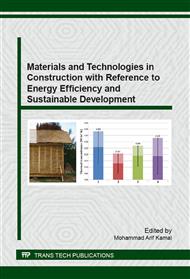[1]
Demirboga R.: Ener. and Build. Vol. 35 (2003), p.189.
Google Scholar
[2]
Laoufi L., Mouli M., Senhadji Y.: Trans Tech Publications/ Key Eng. Mater. Vol. 650 (2015), p.105.
Google Scholar
[3]
Andrade C. and Bajak R.: Cem. Concr. Res. Vol. 53 (2013), p.59.
Google Scholar
[4]
Khan M.I. and Alhozaimy, A.M.: J. Civ. Eng. Vol. 38 (2011), p.71.
Google Scholar
[5]
Mehta P.K.: Cem. Concr. Res. Vol. 11 (1981), p.507.
Google Scholar
[6]
Janotka I. and Krajci L.: Fifth International Conference, Barcelona Vol. 1 (2000), p.223.
Google Scholar
[7]
Mertens G., Snellings R., Van Balen K., Bicer-Simsir B., Verlooy P. and Elsen J.: Cem. Concr. Res. Vol. 39 (2009), p.233.
DOI: 10.1016/j.cemconres.2008.11.008
Google Scholar
[8]
Binici H. and Aksogan O.: Cem Concr Res Vol. 28 (2006), p.39.
Google Scholar
[9]
NF EN 196-5: Test Methods of Cements – Part 5: Pozzolanicity Test for Pozzolanic Cements, Com. Europ. Normal. (CEN), AFNOR, Paris, France, (2006).
DOI: 10.3403/00483028
Google Scholar
[10]
Senhadji Y., Escadeillas G., Mouli M. and Benosman A.S., Eur. J. Environ. and Civ. Eng. Vol. 16 (2012), p.77.
Google Scholar
[11]
Laoufi L.: Mechanical Behaviour and Structural of Concrete in aggressive Environment, PhD thesis, ENPO, Oran, Algeria (2015).
Google Scholar
[12]
Belas Belaribi N., Semcha A. and Laoufi L.: Rev. Canad. Gén. Civ. Vol. 30 (2003), p.580.
Google Scholar
[13]
Senhadji Y., Escadeillas G., Mouli M. and Benosman A. S: Powder Technol. Vol. 254 (2014), p.314.
Google Scholar
[14]
Siad H.: The Durability of Self-compacting concrete based pozzolanic additions and limestone fillers, PhD thesis, University of sciences and technology of Oran, Algeria (2010).
Google Scholar
[15]
Kaid N.: Durability of Pozzolanic Concrete, PhD thesis, University of sciences and technology of Oran, Algeria (2010).
Google Scholar
[16]
Quraishi M.A., Kumar V., Abhilash P.P. and Singh B.N.: J. Mater. Environ. Sci. Vol. 2 (2011), p.365.
Google Scholar
[17]
Hélie M.: Metallic Materials, Corrosion Phenomenon, University of Evry-Val d'Essonne France, (2003).
Google Scholar
[18]
ASTM C 876: Cem. and Aggr. Vol. 4 (2009), p.434.
Google Scholar
[19]
NA 442-03: Hydraulic Binders-Currents Cements, Composition, Specification and Criteria of Conformity, Algeria Standard, (2003).
Google Scholar
[20]
ASTM C 332-09 Standard Specification for lightweight Aggregates for insulating Concrete, ASTM International, West Conshohocken, PA, (2009).
Google Scholar
[21]
ASTM C 109-, 1 In: American Society for Testing and Materials (ASTM) International, West Conshohocken, Pa, (2013).
Google Scholar
[22]
Batis G., Sideris K.K. and Pantazopoulou P., Anti-Corros. Meth. Mater. Vol. 51(2004), p.112.
Google Scholar
[23]
Brown, P.W.: Cem. Concr. Res. Vol. 11 (1981), p.719.
Google Scholar
[24]
Al-Amoudi O. S. B.: Constr. Build. Mater. Vol. 9 (1995), p.149.
Google Scholar
[25]
Shi X., Yang Z. Liu, Y. and Cross D.: Constr. Build. Mater. Vol. 25 (2011) p.3245.
Google Scholar
[26]
Zafeiropoulou T., Rakanta E. and Batis G.: Progress in Organic Coatings Vol. 72 (2011) p.175.
DOI: 10.1016/j.porgcoat.2011.04.005
Google Scholar
[27]
Sakr K.: Cem. Concr. Res. Vol. 35 (2005), p.1820.
Google Scholar
[28]
Parande A.K., Ramesh Babu B., Pandi K., Karthikeyan M.S. and Palaniswamy N.: Constr. Build. Mater. Vol. 25 (2011), p.288.
Google Scholar
[29]
Stewart M. G. and Mullard J.A.: Eng. Struct. Vol. 29 (2007), p.1457.
Google Scholar
[30]
Morabito P.: High Temper. -High Pres. Vol. 21 (1989), p.51.
Google Scholar
[31]
Ashworth T. and Ashworth E., in: R.S. Graves, D.C. Wysocki, Editors, ASTM STP 1916, Philadelphia, Pa 19103, Vol. 2 (1991), p.415.
Google Scholar
[32]
Batis G. Sideris K.K. and Pantazopoulou P.: Anti-Corros. Meth. Mater. Vol. 51 (2004), p.112.
Google Scholar
[33]
Al-amoudi O.S.B.: Build. Environ. Vol. 33 (1998), p.53.
Google Scholar
[34]
Andrade C., and Alonso C.: Constr. Build. Mater. Vol. 10 (1996), p.315.
Google Scholar


